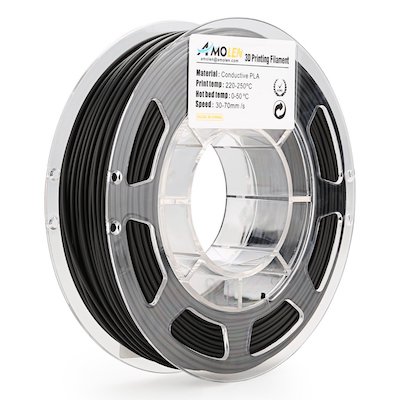The Curious Case of Conductive Filaments
As 3D printing enthusiasts, we have always wondered – what’s next for 3D printing? What else can this technology do? One of the younger and less developed frontiers in 3D printing is the use of conductive filaments, or filaments that are able to conduct electricity.
Conductive filaments are not very common, and probably only the most experienced (or curious) 3D printing hobbyists have dabbled into using them. If you’re curious, then don’t worry because we’ve got you covered. In this article, we tackle everything you need to know about the strange world of conductive filaments – what they are made of, their properties, how to use them, and the best brands available today.
What are conductive filaments?
Practically all the conductive filaments available in the market today are composed of a mixture of carbon and a standard 3D printing plastic. Commercially available conductive filaments come in different base resins: from the standard PLA and ABS, to the more specialized TPU and HIPS. These materials can conduct electricity since the carbon they contain is graphitized – that is, the carbon atoms are arranged in a “honeycomb lattice”, giving it a crystalline structure. Each layer of this structure is called graphite, and the layers are collectively called graphene.
Not only does this structure give a rigidity and strength to the final print, but the nature of the bonds of the carbon atoms leaves a single free electron in each atom. This means that the material can transmit currents through these free electrons, albeit at a much slower rate compared to true conductive materials such as copper and iron.
Graphene is an incredibly thin material, making it appropriate for highly compact applications such as 3D printing filaments. Graphitic carbon has also been used as the main component of conductive inks.
It is important to make a distinction between conductive filaments and filaments infused with ferromagnetic materials. Ferromagnetic or iron-infused filaments may display attraction to magnets, but cannot conduct electricity since the iron particles are too far dispersed within the plastic matrix.
There are also carbon fiber spools available in the market that only contain a small amount of graphene or carbon black. These carbon fiber filaments have unique strength and rigidity due to their carbon content, but their carbon component is too small to afford any conductivity.
What can I do with conductive filaments?
Being able to make custom designed electrical circuits has great potential. In the past, prints made from standard plastic materials had to be incorporated with a conductive material, such as copper wiring, to have electrical capabilities. With conductive filaments, conductive material can be incorporated into the print simultaneous with the entire building process. The result is a much more seamless product with less work involved.
The field of wearable electronics is often cited as one of the best potential beneficiaries of the technology of conductive 3D printing. By using conductive filaments, electrical circuits can be seamlessly blended into practically any clothing fabric. The development of lightweight, durable, and flexible electrical circuitry that can adapt into any shape or form is definitely a huge step in 3D printing technology.
Conductive filaments can also be used to make capacitive sensors. Also known as ‘touch’ sensors, these can be found in most laptop trackpads, digital keyboards, and gaming controllers. They have hundreds of industrial and engineering applications, as these sensors can also be used to detect proximity, acceleration, humidity, and fluid levels. With conductive filaments, you can now make your own capacitive sensors in any shape you want.
The prints made from conductive filaments can also be effectively used as electromagnetic and radio frequency shields. This can be especially useful in the telecommunications field, and in the maintenance of sensitive measuring equipment such as those found in industrial and scientific laboratories. Sensitive and crucial equipment, such as medical devices and other equipment found in health care institutions, can also benefit from using shields against competing signals which may render them faulty. With conductive filaments, you can make highly customized EMI and RF shields for any number of special applications.
What are the limitations of conductive filaments?
The essential limitation of conductive filaments at the state that they are in right now is that they are not as conductive as metals. Conduction through graphite is through a mechanism of electron delocalization within the graphite layers. In comparison, conduction through metals is through a sea of free electrons that are free to move within a lattice, or an “electron cloud”. By this very mechanism, conduction through graphite is slower and quite limited.
Similar to other fused material filaments, conductive filaments are usually more brittle than their standard plastic counterparts. Some special handling will have to be done to ensure that the filament does not break, which includes providing a smooth path from the spool to the extruder.
Another problem you may encounter when using conductive filaments is the accelerated wearing down of the hot-end nozzle due to the infused carbon fiber strands in the filament. In addition to using an abrasion-resistant nozzle, using a wide nozzle (greater than 4mm diameter nozzle) usually addresses this problem.
Conductive filaments are also quite expensive, especially compared to standard ABS or PLA filaments. This means you will probably want to use them sparingly, and there is little room for trial and error.
How do you use conductive filaments?
The variety of base resins used in making conductive filaments means that the printing temperature for each conductive filament product also varies. For instance, the PLA-based conductive filament from ProtoPasta comes with a recommended printing temperature of 220 to 230 °C. On the other hand, the ABS-based conductive filament from Vilarox is to be printed with a recommended temperature of up to 260 °C. In the case of conductive filaments, it is best to follow manufacturer instructions.
A heated bed is usually not necessary for PLA-based filaments, but may help in reducing warping of the final print. A temperature of up to 50 °C should be sufficient if a heated bed is used.
Any method of bed adhesion that works for the base resin should be effective for the conductive filament. A layer of blue painters’tape or glue stick on a glass heated bed usually works well enough for most applications.
AMOLEN recommends a printing speed of 30 mm/s to 70 mm/s for their PLA-based conductive filament. Carbon fiber is very slightly conductive to heat, which means it should heat up and cool down quickly. This characteristic should allow you print at somewhat high printing speeds, but it is still best to consult with the manufacturer.
What are the best brands of conductive filaments available today?
Again, we run into another of the limitations of conductive filaments. They are so underdeveloped and underused that there are really only a handful of manufacturers offering them. Listed below are the best and most reliable brands of conductive filaments available today.

ProtoPasta sells a PLA-based conductive carbon filament, available in 1.75mm size and in 0.5kg spools. This material has a resistivity of only 15 ohm-cm, lower than most other conductive filament products. The conductivity of the ProtoPasta conductive filament allows it for lighting up LEDs, operating capacitive sensors, and for powering low voltage circuits. If you’re looking to try out using a conductive filament, ProtoPasta also offers a mini-sized 0.125kg loose spool for their conductive filament.

The conductive filament sold by AMOLEN is also PLA-based and is sold in1.75mm size and 0.2kg spools. The small spools are great for those who want to try out using conductive filament but do not want to commit to a full-sized spool. Unfortunately, AMOLEN does not list a measured resistivity for their product, so you will have to wing it on that aspect.

For something a little different, you may buy the ABS-based conductive filament from Vilarox. If you need a print that is a little more flexible, then this is the product for you. This filament is available in 1.75mm size and in 1kg spools.
The Roundup
The world of conductive filaments is a relatively young and unexplored field, and there are not many filament products available right now with this capability. As such, printer settings are still non-standard and depend heavily on the base resin used in the filament.
Conductive filaments have not yet reached the state of popularity enjoyed by other specialty filaments such as carbon fiber and metallic filaments, but its capabilities make us very optimistic and excited for the potential of 3D printing technology.




I recently bought an LCD controller for my printer, and that controller is highly sensitive to ESD (I live in the desert and the low humidity leads to a lot of ESD). Would this conductive PLA be useful to print a housing for the controller that would shield it from ESD?
Hi, I think you’ve got your graphene and graphite the wrong way round!